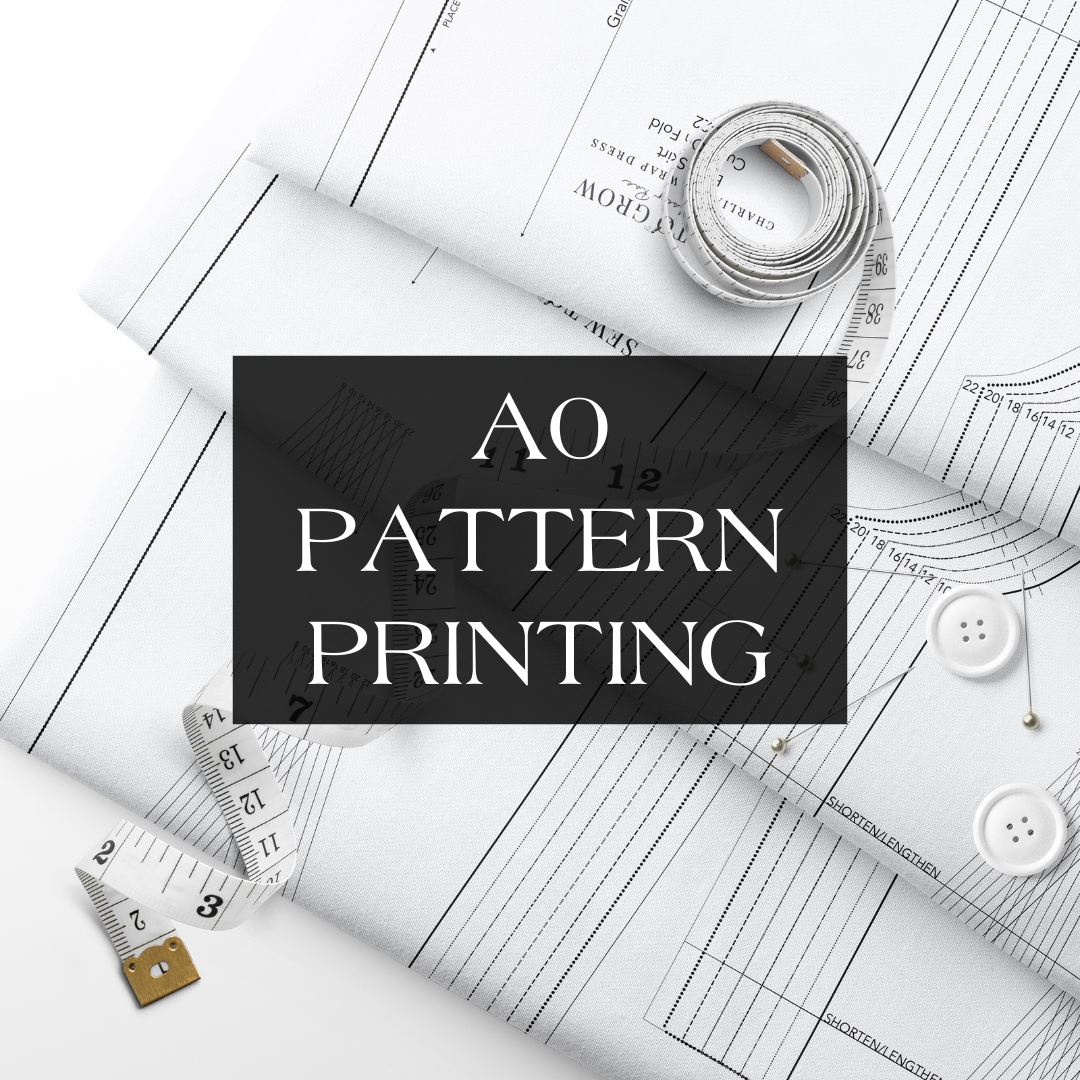Even if you’re new to sewing knits, they probably make up a big chunk of your wardrobe. These fabrics are comfortable, easy to care for, and wrinkle-resistant – great for everyday wear.
However, not all knits are the same. There are a lot of different types of knit fabrics, each with their own unique characteristics.
Today, we’ll be covering the basics of knits as well as several of the most common types of knit fabrics for sewing.

What is a knit fabric?
A knit fabric is really just what it sounds like – a fabric that is formed through knitting threads together.
It’s actually the same process of knitting that you would use if you were to hand-knit a hat or a scarf, except that it’s done on a much larger scale, using tiny little yarns, on a knitting machine. The knitting machine uses needles to loop yarns together, forming fabric.
Since knitted fabrics consist of looped yarns, there is quite a bit of space for air within the structure of the fabric. Also, the looping allows the fabric to have some give, leading to the built-in stretchability of knit fabrics. How much a knit fabric stretches depends on a variety of characteristics, including the pattern of the knit, how thick the yarns are, and the fiber composition of the fabric.
What is the difference between a knit and a woven fabric?
Woven fabrics are not created through knitting, instead they are woven on a loom. When fabric is woven on a loom, two sets of threads – the warp (vertical) and weft (horizontal) – are interlocked at 90-degree angles.
This leads to a tight structure with very little room for give or movement. That’s why woven fabrics don’t stretch unless elastic fibers, such as elastane, are woven in.
2-way stretch vs. 4-way stretch
Often, when shopping for knit fabrics, you’ll see fabrics labelled as either “2-way stretch” or “4-way stretch.” This is an important piece of information to consider, especially if you have a specific project in mind, since it affects the performance of the fabric.
2-way stretch fabrics can only stretch in one direction, typically horizontally, perpendicular to the selvedges. 4-way stretch means that the fabric can stretch both horizontally and vertically.
4-way stretch capabilities are usually necessary for skin-tight garments like swimwear, bodysuits, or leggings.
Make sure to pay attention to the fabric recommendations of the pattern you plan to use – if it calls for a 4-way stretch, using a 2-way stretch fabric may result in a garment that doesn’t fit properly.
Calculating stretch percentage
When working with knit fabrics, it’s important to know how to calculate the stretch percentage of your fabric. Many sewing patterns made for knits will indicate a minimum stretch percentage needed to get optimum results. It’s best to stick to the recommendation of the pattern to make sure your finished garment will fit properly.
Thankfully, figuring out the stretch percentage of a fabric is easy! We’ve put together a simple tutorial on how to calculate stretch percentage for you.

Types of knit fabrics
Let’s talk types of knit fabrics. There are many different knitting patterns that can be used to knit fabrics – but they each fall into one of these two categories: weft-knitted fabrics and warp-knitted fabrics.
Weft-knitted fabrics
Weft knits are the most common type of knit fabric, with many different variations available.
In weft-knitting, one continuous thread is used to create the interlocking loops that form the fabric. In this type of knitting, the stitches progress horizontally, across the width of the fabric. Weft-knitting allows for more variation in the stitches, resulting in many different types of fabric.
Weft-knitted fabrics are generally lighter-weight and stretchier than their warp-knitted counterparts, however they are more time-consuming to produce.
Jersey knit
Jersey knit is one of the most common types of knit fabrics on the market – most likely almost every t-shirt in your closet is made from jersey. In knitting terms, jersey is formed with a stockinette stitch, which is created by alternating rows of knit and purl stitches.
This weft-knitted fabric is generally lightweight, soft, and has a nice drape, making it perfect for relaxed, casual garments.
Rib knit
Rib knit is an easy one to spot because it has distinct, vertical “ribs” running up and down the face of the fabric. These ribs can vary in width, depending on how prominent the manufacturer wants the ribs to be. This weft-knit fabric is formed by creating alternating columns of knit and purl stitches, leading to the appearance of vertical stripes in the fabric.
Rib knit has a lot of stretch, especially in the horizontal direction. It’s usually a bit heavier than jersey, but often has a very soft feel and nice drape.

Interlock knit
Interlock knit fabric is a variation of a rib knit, where instead of forming columns of knit and purl stitches, two layers of fabric are weft-knitted simultaneously on the same machine and are interlocked together. This results in a fabric that looks identical from both sides and is thicker than many other knit fabrics.
Interlock knit has a good amount of built-in stretch, is firmer than other knits, and has good elastic recovery. It’s a durable fabric that is great for activewear.
French terry
French terry is a type of weft-insertion jersey, where additional yarns are inserted crosswise into the fabric as it is knitted. The additional yarns are used to form loops on one side of the fabric, resulting in a fabric with a smooth face and a soft, looped back.
The looped threads on the back of French terry are great for holding in heat, making this thick knit fabric great for sweaters and other cozy garments.

Warp-knitted fabrics
Warp-knitted fabrics are created with multiple threads – each needle loops its own thread, and the stitches are formed vertically, moving down the fabric. This type of knitting is faster to produce but doesn’t allow for much variation in the stitch pattern, meaning that there are fewer types of fabrics made through warp-knitting.
In addition, warp-knitted fabrics tend to be heavier-weight and less stretchy than weft-knits.
Tricot
Tricot knits are formed through vertical rows of thread loops that interlock in a zigzag pattern. The resulting tightly knit fabric has a slight vertical rib texture on the front, and a crosswise rib pattern on the back. Tricot is a relatively dense knit fabric, making it firmer and sturdier than many other knit fabrics.
Tricot is a great choice for activewear or swimwear that needs a firm hold, good recovery, and durability.
Raschel
Raschel knits are a unique type of warp-knitted fabric that must be knitted on a special knitting machine. Raschel knits are made with different weights and types of textured yarn to create intricate, open designs that often look similar to lace or crochet. The appearance and functionality of these fabrics can range significantly depending on the knit pattern and yarns used.
Often, raschel knits don’t stretch very well and can be bulky.






Comments
Thank you for your detailed article on different knit fabrics. It was most interesting reading. I am in my eighties and have been using knit fabrics for years but didn’t realise there were so many different types. I am interested in knits for adults as my days for children’s wear are past. Keep up the good work in producing Australian fabrics.
Thank you for this interesting, well written information. It’s so valuable to have an understanding of how the fabric we use is manufactured. It makes choosing the correct fabric for the purpose required much easier.
One of my biggest dilemmas is choosing a pattern to best use the fabric. I’m a person who drools over fabric first, and then trys to decide what I’d make with it! Would you consider creating basic patterns that suit each knit type? For example, shorts, T-shirt, pyjamas, etc?
One of my biggest dilemmas is choosing a pattern to best use the fabric. I’m a person who drools over fabric first, and then trys to decide what I’d make with it! Would you consider creating basic patterns that suit each knit type? For example, shorts, T-shirt, pyjamas, etc?
Thank you for this – a very good, clear description of the different types of knit fabric. I’ve been using knit fabric for 30 years but I learned so much from this interesting article.
Is it possible to purchase some samples?
Great to see we have fabric manufacturing right here in Australia 🇦🇺. We lost it gradually with manufacing of clothing the best names vanished along with the fabric department store, and fabric shops who stopped selling fabric and the options were cheap second quality imported fabrics. I’ll share this with fellow sewers thank for making Australia 🇦🇺 great again.
Wow, great overview of the different types. Now I know what I didn’t know before: that I want to try out some interlock knits and warp-knitted fabrics. I want to create some strong sports-wear that’s still stretchy but strong enough to wear as outdoor wear.
I want to make a structured lined skirt which suggests a cotton knit fabric. I would like to see examples of skirts/dresses made with this type of fabric. What lining fabric to use with knit 220. Thanks Jen